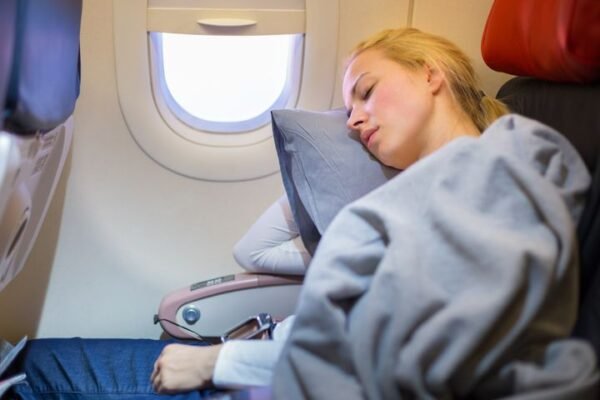
Sleep Expert Shares 11 Tips for Getting the Best Sleep on a Plane

With disruptive noises, bright cabin lights, uncomfortable seats and often limited legroom, trying to get a restful sleep on a plane can be quite the challenge. Dr Lindsay Browning, neurologist, psychologist and sleep expert at And So To Bed has provided her top tips for dozing off on a plane.
1. Selecting the right seats
Although with most airlines, there is an additional charge for booking your seat in advance, if you are looking to get some rest on your flight then it might be worth it.
While a window seat may initially appear appealing for undisturbed rest, it’s important to consider the trade-offs. This seat selection indeed helps avoid interruptions from fellow passengers requiring aisle access. However, if you are seated near the engines, you may experience more noticeable noise and vibrations compared to an aisle seat.
To optimise your chances of getting some much-needed rest on a flight, it is recommended to book a seat either in front of or behind the wings and engines, while choosing a window seat. This seating arrangement strikes a balance between minimal disturbances and a quieter environment conducive to sleep.
To minimise disruptions to your sleep during your flight, you should avoid seats that are within close proximity to the restrooms, which are typically positioned at the front and back of the plane. These areas often attract gatherings of passengers and serve as preparation zones for flight attendants, especially for trolley services. Due to increased activity and conversations, disturbances are more likely to occur in these sections.
If you are travelling with another person, a useful tip is to book the window seat and the aisle seat, leaving the middle seat vacant. Typically, middle seats are among the last to be booked. If the plane isn’t fully booked, you may get lucky and secure the entire row for yourselves. However, if another passenger does happen to be assigned the middle seat, you might find that they are willing to switch seats with either the window or aisle seat, hopefully allowing you and your travel companion to sit together.
2. Layer up
To combat the chilly temperatures often experienced on planes, it’s advisable to layer up with comfortable jumpers. These layers can serve a dual purpose as both pillows and blankets, providing additional warmth and cosiness during the flight. Additionally, to enhance your comfort further, you might want to consider packing a pair of cosy socks to keep your feet warm and snug.
3. Use a jumper or blanket as a lumbar support
Sleeping while sitting up is never ideal, however for added comfort and to improve spinal alignment, consider placing a jumper or spare blanket/pillow beneath the lower part of your back, specifically supporting the lumbar spine. This pillow will support the natural curvature of the lower spine, even if you slouch or move during your sleep. Additionally, even though it may be unpopular with those behind you, reclining your seat can help keep you more comfortable while you sleep on the plane. The more you can increase your overall comfort during the flight, then the easier it will be to fall asleep.
4. Good quality earplugs and a sleep mask
Planes are not the easiest places to sleep with a lot of noise, light and distractions. Try using earplugs, eye masks or noise-cancelling headphones to block out the background noise and lights. These accessories can effectively block out background noise and reduce the impact of ambient lights, helping you to create a more tranquil and sleep-friendly atmosphere.
5. Drink plenty of water on your flight
You should drink plenty of water before, during and after your flight to counteract the dehydrating effects of the dry air in the plane cabin. Dehydration has been shown to make jet lag symptoms worse. It can also cause symptoms such as a scratchy throat and eye irritation making it harder to fall asleep.
6. Avoid excess alcohol
While alcohol is a sedative and can help you fall asleep easier, you should stay away from alcohol on your flight. Alcohol can lead to more awakenings and worse sleep quality including less REM sleep.
The after-effects of heavy alcohol consumption (i.e. a hangover) not only affect your sleep but also your daytime cognitive and psychomotor performance the next day meaning you will wake up feeling more dehydrated, groggy and can worsen the effects of jet lag.
7. Avoid crossing legs – use a footrest instead
According to the Center for Disease Control and Prevention, crossing your legs on a long flight can lead to increased pressure on one side of your body, potentially restricting blood flow and raising the risk of blood clots. To promote better circulation and reduce this risk, it is recommended to keep both legs straight with a slight bend in your knees, rather than crossing your legs, even if it feels more relaxing.
It is also beneficial to keep the under-seat area clear of personal items and bags. This creates more space for stretching your legs and enables proper circulation to your feet.
8. Create a bedtime routine on the plane
Just like you would at home, you should create a bedtime routine on the plane to get your mindset into bedtime mode. This could be as simple as brushing your teeth, doing your nighttime skincare routine, and reading a book. This will trick your mind into thinking it is your normal routine before bed, helping you feel more relaxed and comfortable.
Make sure that you switch off your electronic devices an hour before bed, in particular, your phone. Smartphones emit bright light which has the same effect on melatonin production as daylight. The light tricks the brain into thinking it is daytime which can make it difficult to transition into sleep mode when bedtime rolls around. Try reading a book or meditating before you sleep instead.
9. Avoid Caffeine consumption
If you’re hoping to get some sleep on your flight then you’ll want to avoid drinking any caffeine close to your flight. Caffeine has an average half-life of around 6 hours. That means that 6 hours after your cup of coffee, half of the caffeine is still in your system keeping you awake.
Caffeine is not only found in tea and coffee but also in chocolate and soft drinks such as cola and energy drinks, including sugar-free varieties.
10. Move into the time zone as soon as possible
To help lessen the effects of jet lag you should gradually adjust your sleep schedule before your trip. This means moving your bedtime and wake time gradually a few days before the trip nearer to the destination time zone. That way, when you go on holiday you will be closer to the new time zone. Your body will have already started to naturally adjust, making jet lag less severe.
If you’re travelling east, try going to bed one hour earlier each night for a few days before your departure. Go to bed one hour later for several nights if you’re flying west. Setting your watch to your new time zone before you leave can help you stay on your new schedule.
11. Start eating meals in the new time zone as soon as possible
Similar to your bedtime, you should start gradually adjusting your mealtimes closer to the time you’ll be eating them at your destination.
You might want to skip the aeroplane meal (or have it later) if you would be asleep at your destination time. If possible, eat meals closer to the time you’ll be eating them at your destination.












































